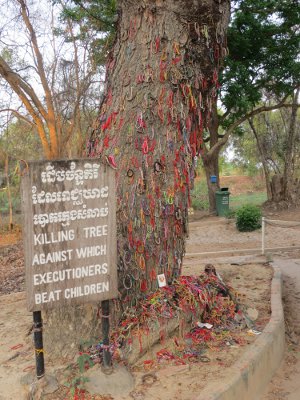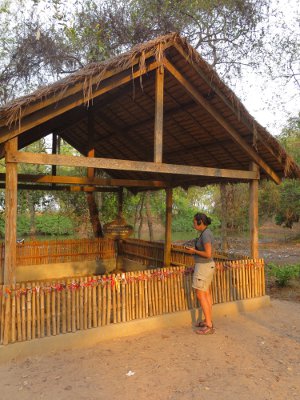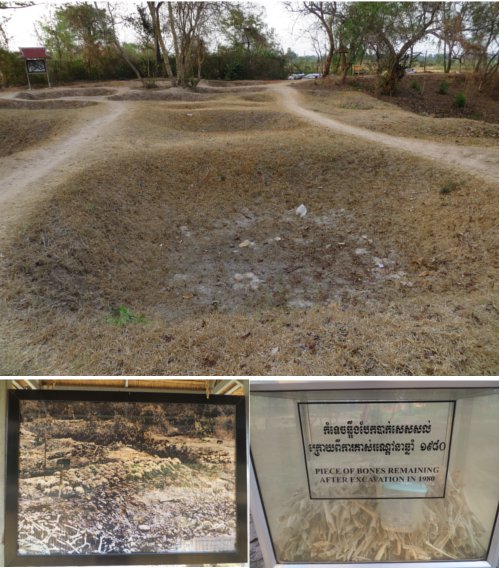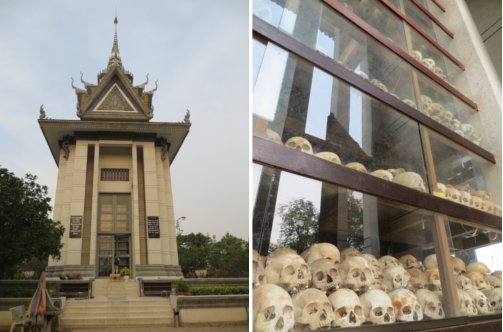Cambodian Genocide
During our days in the capital of Cambodia, Phnom Penh, we got to visit the Toul Sleng Genocide Museum and Choueng Ek Genocide Center, former security office 21 and killing fields during the “Democratic Kampuchea”, respectively. These two places are revealing and educational testimonies of the horrors suffered by the Cambodian society under the regime of the Khmer Rouge. We couldn’t believe all that happened and we now feel more aware about the importance of advocating on behalf of human rights. Visiting the killing fields touched us deeply, their guided narratives of the genocide transported our minds back to those terrible nights in which many innocent lives were silenced and abandoned in communal burials. We felt eager to share this tragedy of humanity with you, hoping that their pain won’t be forgotten or repeated anywhere else in the world.


From 1975 to 1979 Cambodian people lived under the dark and fear of the “Khmer Rouge”, an army group of extreme communist ideas lead by Pol Pot. The Khmer Rouge wanted to convert Cambodia in a self-sustainable farming country that could be independent from capitalism. Their method of trying to attain this goal was to force people to leave their homes, separate from their family members, and move to remote countryside in conditions close to slavery, where they were expected to work the land for up to 15 hours per day without proper food. Schools, temples, markets, and entire cities, including Phnom Penh, were closed and evacuated. The Khmer Rouge believed that education wasn’t needed and transformed schools into centers of detention for interrogation, torture, and killing. We got to visit an example of this conversion at the Toul Sleng Genocide Museum, which previously was a primary school. It is estimated that 20,000 Cambodians were detained, torture, and assassinated between 1975 to 1978 in Toul Sleng, not including children. Following the idea “to weed the land you have, you must remove the root”, the Khmer Rouge eliminated entire families of innocent people, as a way to prevent future retaliation against the regimen. In total, the country suffered a loss of about 25% of their population or approximately 3 million people in almost 4 years.

The Khmer Rouge army was formed by Cambodian leaders who recruited mostly young people with the promises of a better future. At the end, it was a horrible cycle of Cambodians killing their own people because those who refused to obey were also executed. Cambodia was eventually liberated by the Vietnam Government in 1979 and the main leaders of the Khmer Rouge were exiled toward the Thailand borders. Nevertheless, the Khmer Rouge was recognized and invited to United Nations meetings to represent Cambodia until 1993. Looking at history, we can’t stop to wonder why the UN and other countries didn’t do anything to help Cambodians and instead continued to give political recognition to the Khmer Rouge. Was it because they have just lost the war against communism in Vietnam and they didn’t want to acknowledge that Vietnam, a Communist country was actually saving Cambodia? The truth is that human barbaric actions come from all races, ideas, religions, and political parties. The issue continues to be a matter of respecting our differences and valuing the life of others over an irrational need of power and control.


The horrors of Cambodia genocide weren’t internationally recognized until recently and it was just in 2007 when the still living leaders of Khmer Rouge started to be tried for their crimes. We want to invite you to research and learn more about this tragedy, “those who don’t know their history are condemned to repeat it”. You may find the following links helpful:
Documentation Center of Cambodia
Transcultural Psychosocial Organization
Khmer Rouge Tribunal
www.eccc.gov.kh
University of Yale – Cambodian Genocide Program
www.yale.edu/cgp
